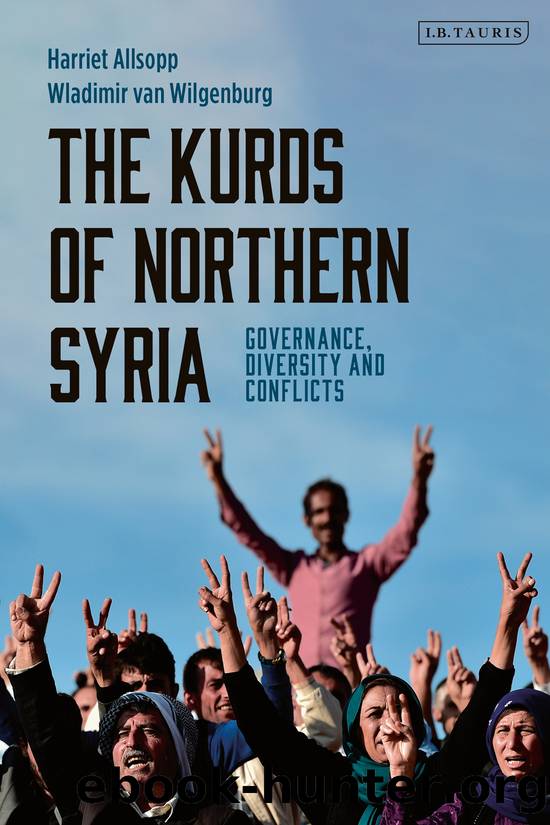The Kurds of Northern Syria by Harriet Allsopp;Wladimir van Wilgenburg;

Author:Harriet Allsopp;Wladimir van Wilgenburg;
Language: eng
Format: epub
ISBN: 9781788315975
Publisher: Bloomsbury UK
KNCâPYD tensions and political opposition
In this manner, local, sectarian and other tensions also translated into political ones. This was equally true within Kurdish areas. Although ethno-nationalism was rejected by the PYD and the creation of an ethnic Kurdish nation state was removed completely from the PYD and PKK agenda in 2005, organization around ethnic and local identities remained strong in Syria among both Arabs and Kurds. Differences between the models of federalism envisaged by the PYD and the KNC were highlighted and problematized with the extension of the YPG into non-Kurdish majority areas.
Hediya Yousef, the co-head of the federal system said:
We donât want to make a Kurdistan border, maybe historically some of these areas belong to Kurdistan, but it doesnât matter to us if a region historically belongs to Kurds or Arabs. Our federal system is not based on geography, but based on communities. ⦠If Raqqah is liberated it could also join. ⦠We donât want a country to oppress the people. They can have their own self-administration.181
Nevertheless, expansion into non-Kurdish areas caused many Kurdish nationalists to criticize the PYD and the YPG for fighting in Arab areas that were not part of historic Kurdish lands. This led also to denigration from Syrian opposition groups, some of which suggested that the Kurds were âoccupying Arab areasâ and displacing Arabs.182 More generally, the PYD was seen to have removed Kurdish symbolism from its governance and followed a non-Kurdish project that prioritized coexistence with Arabs over unresolved, and specifically, Kurdish interests framed by the idea of the Kurdish nation and âKurdistanâ:
They donât have a national project: not a Kurdish state nor Kurdish rights. ⦠They are allied to the PKK and they are left-wing, not Kurdish. They have no project for Kurds. (Mohammed Ismail, a leading KDP-S politician) 183
Concerns were expressed by Syrian Kurds over the large number of Arab refugees in Kurdish majority cities, such as Qamishli, which, it was feared, would produce irreversible demographic changes.184 The DAA officials suggested that the Kurdish regions hosted over 1.8 million IDPs from all over Syria185 in addition to thousands of Arab refugees from Mosul. The migration of Kurds out of northern Syria exacerbated Kurdish concerns about irreversible demographic change and its consequences for Kurdish nationhood. Some Syrian Kurds also expressed distrust of Arab fighters that worked with the YPG, suggesting that they could betray the Kurds or work with the regime in the future and further undermine and endanger efforts to secure Kurdish rights.186
This was not to say that the KNC sought an ethnically pure federal entity, or that those who were opposed to the PYD project did so because of a belief in ethnic exclusivity. On the contrary, the federal model proposed by the KNC also included recognition and representation of all ethnic and religious groupings. The formation of a federal unit akin to that in Iraqi Kurdistan was not considered geographically viable or, for the PYD, congruent with its ideology. The difficulties in forming such an entity in Syria had long been recognized by Kurdish politicians from diverse backgrounds.
Download
This site does not store any files on its server. We only index and link to content provided by other sites. Please contact the content providers to delete copyright contents if any and email us, we'll remove relevant links or contents immediately.
| Africa | Americas |
| Arctic & Antarctica | Asia |
| Australia & Oceania | Europe |
| Middle East | Russia |
| United States | World |
| Ancient Civilizations | Military |
| Historical Study & Educational Resources |
The Battle of Mogadishu by Matt Eversmann & Dan Schilling(610)
The Confidence Men by Margalit Fox(534)
The Spymaster of Baghdad by Margaret Coker(533)
A History of the Muslim World since 1260: The Making of a Global Community by Vernon O. Egger(516)
Jack the Ripper and the East End by Peter Ackroyd(472)
Empire of Fear: Inside the Islamic State by Andrew Hosken(464)
Islam At The Gates: How Christendom Defeated the Ottoman Turks by Diane Moczar(460)
The Crimean War by Winfried Baumgart(460)
The Afghanistan File by Prince Turki AlFaisal Al Saud(456)
The Jerusalem Diamond by Noah Gordon(454)
Akhenaten by Dominic Montserrat(442)
A Concise History of Greece (Cambridge Concise Histories) by Richard Clogg(441)
Israel: Ancient Kingdom or Late Invention? by Daniel I. Block(438)
The History of Jihad by Robert Spencer(430)
Enemy in the East by Rolf-Dieter Müller(428)
The Privatization of Israeli Security by Shir Hever(425)
Destroying a Nation: The Civil War in Syria by Nikolaos van Dam(423)
The Nine Lives of Pakistan by Declan WALSH(415)
The Dirty War in Kashmir by Shujaat Bukhari(404)
